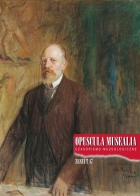Muzeum uniwersyteckie (MUSA): dziedzictwo czego?
A University Museum (MUSA): whose heritage?
Author(s): Ian CarradienceSubject(s): Cultural Essay, Political Essay, Societal Essay
Published by: Wydawnictwo Uniwersytetu Jagiellońskiego
Keywords: University of St Andrews; university museum; culture heritage
Summary/Abstract: The University of St Andrews was founded in the early 15th century, making it Scotland’s first University and the third oldest in the English speaking world. The University has a long history of recognising its heritage, with records of visitors being shown buildings, monuments and artefacts (‘treasures’) dating back as far as the seventeenth century. In the 18th century a ‘Collection of Curiosities’ was displayed in the University Library and in 1838 these items were transferred to a museum being established jointly by the University and the newly-founded St Andrews Literary and Philosophical Society. This museum’s mixed collections, including natural history, archaeology and ethnography, were transferred in 1911–1912 to new premises and renamed the Bell Pettigrew Museum (in honour of a St Andrews Professor whose widow funded the new museum). The Bell Pettigrew Museum was regarded as the ‘town museum’ for a few decades, but from the 1950s it was reduced in size and many of its collections were dispersed around the University while the Bell Pettigrew became a specialist zoological museum for University teaching. In the meantime, other departments had also established collections (of specimens or instruments) for teaching or research and at various times displayed these collections in rooms that might also be visited by the public (such displays included chemistry, geology, anatomy and pathology, archaeology and historic scientifi c instruments).
Journal: Opuscula Musealia
- Issue Year: 2010
- Issue No: 17
- Page Range: 23-30
- Page Count: 11
- Language: English

